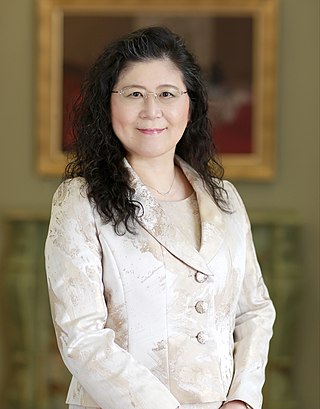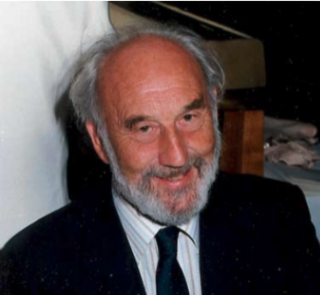Related Research Articles

Caenorhabditis elegans is a free-living transparent nematode about 1 mm in length that lives in temperate soil environments. It is the type species of its genus. The name is a blend of the Greek caeno- (recent), rhabditis (rod-like) and Latin elegans (elegant). In 1900, Maupas initially named it Rhabditides elegans. Osche placed it in the subgenus Caenorhabditis in 1952, and in 1955, Dougherty raised Caenorhabditis to the status of genus.

Sydney Brenner was a South African biologist. In 2002, he shared the Nobel Prize in Physiology or Medicine with H. Robert Horvitz and Sir John E. Sulston. Brenner made significant contributions to work on the genetic code, and other areas of molecular biology while working in the Medical Research Council (MRC) Laboratory of Molecular Biology in Cambridge, England. He established the roundworm Caenorhabditis elegans as a model organism for the investigation of developmental biology, and founded the Molecular Sciences Institute in Berkeley, California, United States.

Howard Robert Horvitz ForMemRS NAS AAA&S APS NAM is an American biologist best known for his research on the nematode worm Caenorhabditis elegans, for which he was awarded the 2002 Nobel Prize in Physiology or Medicine, together with Sydney Brenner and John E. Sulston, whose "seminal discoveries concerning the genetic regulation of organ development and programmed cell death" were "important for medical research and have shed new light on the pathogenesis of many diseases".

Sir John Edward Sulston was a British biologist and academic who won the Nobel Prize in Physiology or Medicine for his work on the cell lineage and genome of the worm Caenorhabditis elegans in 2002 with his colleagues Sydney Brenner and Robert Horvitz at the MRC Laboratory of Molecular Biology. He was a leader in human genome research and Chair of the Institute for Science, Ethics and Innovation at the University of Manchester. Sulston was in favour of science in the public interest, such as free public access of scientific information and against the patenting of genes and the privatisation of genetic technologies.
WormBook is an open access, comprehensive collection of original, peer-reviewed chapters covering topics related to the biology of the nematode worm Caenorhabditis elegans . WormBook also includes WormMethods, an up-to-date collection of methods and protocols for C. elegans researchers.
Caenorhabditis briggsae is a small nematode, closely related to Caenorhabditis elegans. The differences between the two species are subtle. The male tail in C. briggsae has a slightly different morphology from C. elegans. Other differences include changes in vulval precursor competence and the placement of the excretory duct opening. C. briggsae is frequently used to study the differences between it and the more intimately understood C. elegans, especially at the DNA and protein sequence level. Several mutant strains of C. briggsae have also been isolated that facilitate genetic analysis of this organism. C. briggsae, like C. elegans, is a hermaphrodite. The genome sequence for C. briggsae was determined in 2003.

Cynthia Jane Kenyon is an American molecular biologist and biogerontologist known for her genetic dissection of aging in a widely used model organism, the roundworm Caenorhabditis elegans. She is the vice president of aging research at Calico Research Labs, and emeritus professor of biochemistry and biophysics at the University of California, San Francisco (UCSF).
John Graham White is an Emeritus Professor of Anatomy and Molecular Biology at the University of Wisconsin–Madison. His research interests are in the biology of the model organism Caenorhabditis elegans and laser microscopy.

Most animal testing involves invertebrates, especially Drosophila melanogaster, a fruit fly, and Caenorhabditis elegans, a nematode. These animals offer scientists many advantages over vertebrates, including their short life cycle, simple anatomy and the ease with which large numbers of individuals may be studied. Invertebrates are often cost-effective, as thousands of flies or nematodes can be housed in a single room.
Barbara J. Meyer is a biologist and genetist, noted for her pioneering research on lambda phage, a virus that infects bacteria; discovery of the master control gene involved in sex determination; and studies of gene regulation, particularly dosage compensation. Meyer's work has revealed mechanisms of sex determination and dosage compensation—that balance X-chromosome gene expression between the sexes in Caenorhabditis elegans that continue to serve as the foundation of diverse areas of study on chromosome structure and function today.
Catharine Anastasia Conley was NASA's 6th Planetary Protection Officer from 2006 through 2018.
The nematode worm Caenorhabditis elegans was first studied in the laboratory by Victor Nigon and Ellsworth Dougherty in the 1940s, but came to prominence after being adopted by Sydney Brenner in 1963 as a model organism for the study of developmental biology using genetics. In 1974, Brenner published the results of his first genetic screen, which isolated hundreds of mutants with morphological and functional phenotypes, such as being uncoordinated. In the 1980s, John Sulston and co-workers identified the lineage of all 959 cells in the adult hermaphrodite, the first genes were cloned, and the physical map began to be constructed. In 1998, the worm became the first multi-cellular organism to have its genome sequenced. Notable research using C. elegans includes the discoveries of caspases, RNA interference, and microRNAs. Six scientists have won the Nobel prize for their work on C. elegans.
Jonathan Alan Hodgkin is a British biochemist, Professor of Genetics at the University of Oxford and an emeritus fellow of Keble College, Oxford.

Caenorhabditis elegans- microbe interactions are defined as any interaction that encompasses the association with microbes that temporarily or permanently live in or on the nematode C. elegans. The microbes can engage in a commensal, mutualistic or pathogenic interaction with the host. These include bacterial, viral, unicellular eukaryotic, and fungal interactions. In nature C. elegans harbours a diverse set of microbes. In contrast, C. elegans strains that are cultivated in laboratories for research purposes have lost the natural associated microbial communities and are commonly maintained on a single bacterial strain, Escherichia coli OP50. However, E. coli OP50 does not allow for reverse genetic screens because RNAi libraries have only been generated in strain HT115. This limits the ability to study bacterial effects on host phenotypes. The host microbe interactions of C. elegans are closely studied because of their orthologs in humans. Therefore, the better we understand the host interactions of C. elegans the better we can understand the host interactions within the human body.

Anton Gartner is a geneticist and biologist utilizing the nematode worm Caenorhabditis elegans as a model system He is a distinguished professor at the Ulsan National Institute of Science and Technology (UNIST) in Korea and is one of the two associate directors of the IBS Center for Genomic Integrity located on the UNIST campus.
Eileen Southgate is a British biologist who mapped the complete nervous system of the roundworm Caenorhabditis elegans, together with John White, Nichol Thomson, and Sydney Brenner. The work, done largely by hand-tracing thousands of serial section electron micrographs, was the first complete nervous system map of any animal and it helped establish C. elegans as a model organism. Among other projects carried out as a laboratory assistant at the Medical Research Council Laboratory of Molecular Biology (MRC-LMB), Southgate contributed to work on solving the structure of hemoglobin with Max Perutz and John Kendrew, and investigating the causes of sickle cell disease with Vernon Ingram.
Paul W. Sternberg is an American biologist. He does research for WormBase on C. elegans, a model organism.
Alexander Gottschalk is Professor of Cellular and Molecular Neurobiology at the Goethe University in Frankfurt, Germany.

Ikue Mori is a Japanese scientist. She is known for her work on molecular, cellular and neural circuit analyses of thermotaxis behavior in C. elegans. She is Director of Neuroscience Institute and Professor of Molecular Neurobiology of the Graduate School of Science in Nagoya University, Japan. In 2013, she became the first woman to receive Tokizane Award, the most prestigious neuroscience award in Japan, and in 2017, was awarded Medal of Honor with Purple Ribbon.

Warwick Llewellyn Nicholas (1926–2010) was an Australian zoologist known as a pioneer in the field of nematology. He was a foundational member of the Australian Society for Parasitology (ASP) and in 1964, he organised the first ASP meeting. He became President of the Society in 1978, before being an elected Fellow from 1979.
References
- ↑ "Dr. Siegfried Hekimi". McGill University. Retrieved 17 December 2015.
- ↑ "Siegfried Hekimi". Pro Cycling Stats. Retrieved 11 April 2015.
- ↑ Dr Siegfried Hekimi: profile - Montreal Diabetes Research Center
- ↑ mdrc.ca
- ↑ hekimilab.mcgill.ca
- ↑ ABC Science - Free radicals not such a bad thing
- ↑ The Molecular Genetics of Aging pp 81-112 | Crossroads of Aging in the Nematode Caenorhabditis elegans